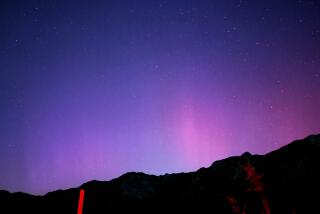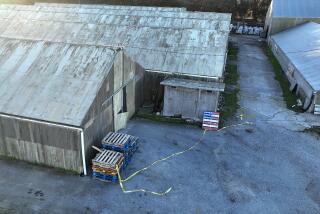New Era for Old Foes in Water Wars
Richard Harasick is a Los Angeles Department of Water and Power manager who has spent the last 18 months doing something heretical.
He has overseen construction of an elaborate system that siphons water from the city’s Sierra aqueduct and delivers it onto the barren flats of the Owens Lake bed.
For the record:
12:00 a.m. Dec. 2, 2001 FOR THE RECORD
Los Angeles Times Sunday December 2, 2001 Home Edition Part A Part A Page 2 A2 Desk 2 inches; 43 words Type of Material: Correction
Owens Lake--A California section story Nov. 18 on dust control at Owens Lake incorrectly reported that CH2M Hill is the company building an irrigation system on the lake’s dry bed. CH2M designed the system and is overseeing its construction. Barnard Construction Co. of Bozeman, Mont., is installing it.
For the first time since William Mulholland opened the sluice nearly 90 years ago and declared to Los Angeles, “There it is. Take it,” the DWP is sending water into Owens Lake.
As part of a $62-million effort to end the choking dust storms that swirl off the dry lake bed, the DWP is installing what amounts to a giant irrigation system.
The first water started flowing from bubblers Nov. 7. By the end of December, the DWP will be irrigating 10 square miles of Owens Lake, which it transformed into a dusty icon of Western water wars.
The intent is not to cover the lake bed with water, but to turn its most dust-prone portions into mud that won’t blow away.
“There’s hardly a way for it to fail,” said Theodore Schade, senior project manager for the Great Basin Unified Air Pollution Control District. “It’s not complicated. It’s just big.”
His agency, which oversees air quality in Inyo, Mono and Alpine counties, battled Los Angeles for years before the DWP agreed in 1999 to the dust-control plan. Now Schade says they are working well together to clean up among the worst particle air pollution in the nation.
When wind blows down the Sierra peaks and over the 110-square-mile lake bed, it stirs up dense clouds of dust laced with naturally occurring toxic chemicals. The swirls are at times thick enough to get lost in--thick enough, Schade said, to kill anyone trapped in them for hours.
Particle pollution 50 times the federal clean air standard has been measured in the worst Owens Valley dust storms. The DWP has promised to do whatever it takes to bring the region into clean air compliance by 2006.
The department is following two courses of action. It is shallow-flooding 13 1/2 square miles of the lake bed and planting salt grass on an additional three square miles.
The lake dried up in the 1920s after the DWP diverted the Owens River, the lake’s source, into the Los Angeles Aqueduct, sending the water 250 miles south to the fast-growing city’s spigots and gardens.
To bring some of it back, the DWP has embarked on a massive construction project, installing 300 miles of underground water pipe--some of it 5 feet in diameter--and 5,000 irrigation bubblers. The agency is scraping 20 miles of service roads in the dirt, building pump houses and laying fiber-optic and electrical wiring to operate the system.
Most dramatically, the DWP is tapping into Mulholland’s aqueduct at two spots near the lake.
“That has a significant symbolism for us,” said Harasick, assistant director of water resources at the DWP. “That’s a real emotional issue, to put good, clean drinking water on the lake bed. But we’re over that.”
The DWP initially wanted to pump ground water onto the lake bed rather than diverting water from the aqueduct. That proposal died amid concerns that the pumping would dry up nearby wetlands and municipal wells.
When the irrigation project is in full swing, about 10% of the aqueduct’s flow will be piped to the lake, enough water to supply more than 60,000 homes. Harasick said the DWP will compensate for that loss with conservation and future water transfers from other sources.
The air pollution district and DWP had considered other approaches--from laying gravel to using chemicals to control dust. Businessmen had their own suggestions: Line the lake bed with old tires or compressed trash.
In the end, the agencies settled on the same material that nature had used: water.
“We found the things that have worked the best are the things that mimic the natural environment,” said Schade, who conducted various experiments on the lake bed, including a successful test of the shallow-flooding technique.
His agency is now researching salt grass, a native plant that holds down the dust and tolerates the dry bed’s high levels of naturally occurring salts.
Test plots of the clumping, foot-tall grass are doing well. Salt grass will use less water than the shallow flooding, but it still requires irrigation.
The lake bed never completely dried up. A small flow from the Owens River still reaches it. Springs and a high water table create scattered, shallow pools amid the crusty expanses of sand and clay.
Still, the irrigation project will reintroduce water to an extent not seen since Los Angeles bought up the Owens Valley’s water rights and sent its clear mountain-fed river south.
“This will change the ecosystem, from bugs to birds to things that crawl in the ground,” said Guy Hagen of CH2M Hill, the Colorado construction company building the irrigation system.
Schade said he expects migrating shore birds to begin visiting the new mud flats. Life may be about to return to Owens Lake.
More to Read
Start your day right
Sign up for Essential California for news, features and recommendations from the L.A. Times and beyond in your inbox six days a week.
You may occasionally receive promotional content from the Los Angeles Times.





